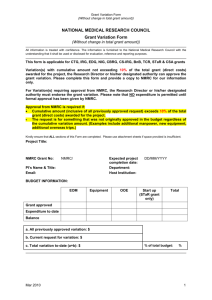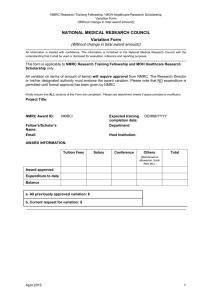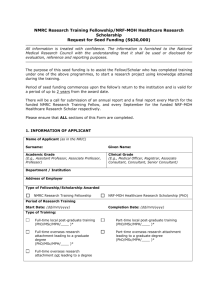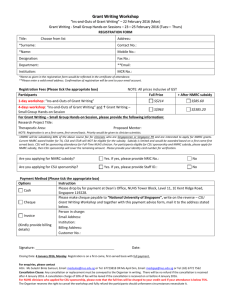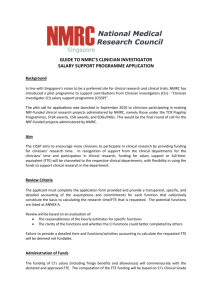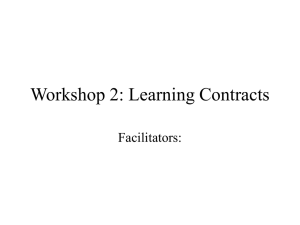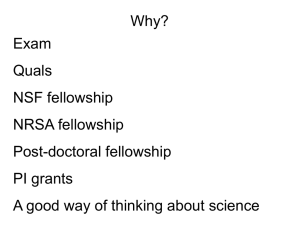Preparing for national, independent grants
advertisement
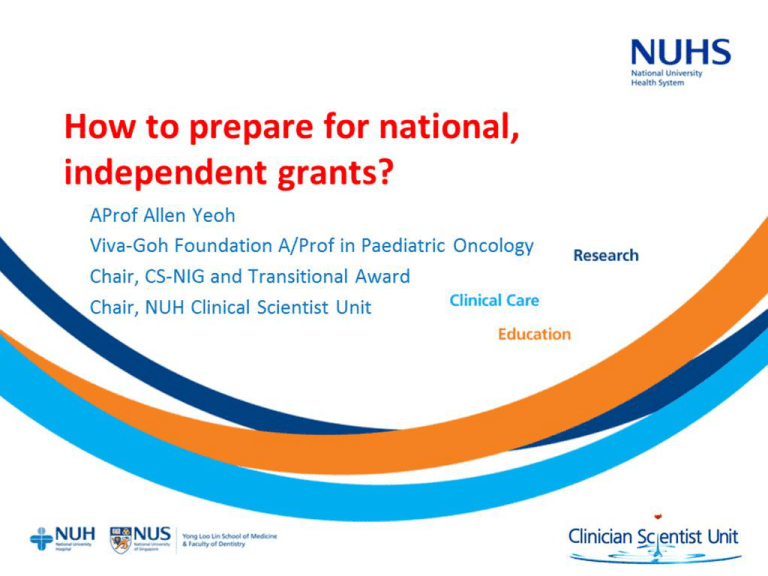
How to prepare for national, independent grants? (CS-IRG) AProf Allen Yeoh Viva-Goh Foundation A/Prof in Paediatric Oncology Chair, CS-NIG and Transitional Award Chair, NUH Clinical Scientist Unit To promote excellence in translational and clinical research, nurture a vibrant research community of clinicians and scientists in Singapore, and enhance knowledge translation for health and economic outcomes. Ranga Krishnan NMRC Chairman • NMRC hopes to provide a conducive environment to attract new clinician scientists and retain existing ones to do research. CS-IRG/NIG funding 45 40 35 30 25 20 15 10 5 0 IRG NIG 2004 2005 2006 2007 2008 2009 2010 2011 2012 2013 NMRC Annual Report 2011 - 2013 Clinician Scientist-IRG success rates 100% 90% 80% 70% 60% 50% 40% 30% 20% 10% 0% CS-NIG (Ave 29%) CS-IRG (Ave 22%) NMRC Annual Report 2011 - 2013 Cooperative Basic-IRG Success rates 100% 80% 60% CB-NIG 40% 20% CB-IRG 0% Jan-11 Jan-12 Jan-13 NMRC Annual Report 2011 - 2013 CS-IRG Review Process Rejection IRG Submission International Review 3/5 Pass cut-off score Rebuttal 3 page LRP score N=2 Score Range Upper-Lower Local Review Panel Scores Funding cut-off point CS-IRG Review Process Rejection IRG Submission International Review 3/5 Pass cut-off score Rebuttal 3 page LRP score N=2 Score Range Upper-Lower Local Review Panel Scores Funding cut-off point Reviewers International Reviewer • Expert in the field • Token of payment for review • Quality of review Local Review Panel • Expert, established researchers • Doing NMRC a favour to review • Little interest in your grant – impt to interest them • Summarise and Present International Review, Rebuttal and their reviews Idea: What is the problem? • Define the problem or need to study • Important clinical problem that you, your peers and experts in your field face as doctors • Start > 6 months ahead; 3 afternoon/week • Attend top conferences in your field • read articles from top journals in field and general – NEJM, Cell/Nature/Science “Good artists copy, great artists steal.” Pablo Picasso Read the grant application carefully • Download current CS-IRG form from NMRC • Highlight all questions you must answer and materials you have to include. Underline key words or phrases you might want to use. – Before you start writing—brainstorm with team, collaborators – Why should NMRC fund you? BIG is beautiful – so collaborate! Abstract : Most important • • • • Executive summary what you want to do. Reviewers read this first to understand scope Spend most time to craft this abstract Avoid errors or inconsistencies especially in numbers • Summarise every thing that is important and most exciting for research proposal • Think critically how different parts link up together • Flow and information self-contained • Eliminate not important information – no reference • Readable – avoid many short forms or special words • 300 words is sufficient First Paragraph: Grab attention • Summarise problem and gap in knowledge • Why NMRC should fund the study to solve the problem? Second paragraph – specific aims, hypothesis etc. Conclusion – how the study will address the gap. Use the NMRC form to create outline The outline should follow, painstakingly, the sequence and terms prescribed by NMRC. In no more than 12 pages (page limit excludes the reference section), include the following sections in the research proposal. Please use Arial font size 10 for all text. Specific Aims & Hypothesis Background & Clinical Significance Preliminary Studies/Progress report Methods/Approach How the research furthers the vision/mission of NMRC Roles of Team Members References Aims and Background • Specific Aims & Hypothesis State concisely and realistically what the study intends to accomplish and what hypothesis is to be tested. • Background & Clinical Significance Briefly sketch the background of the research proposed, critically evaluate existing knowledge and specifically identify the gaps which the project intends to fill. State concisely the importance of the research described by relating the specific aims to both short term (3-5 years) and possible long term clinical implications. Preliminary data NMRC aims Describe how your research will contribute to: • solving the health problem; • develop new knowledge relevant to improving health; • develop scientific and clinical applications; and • developing knowledge in biomedical sciences and providing tangible improvements in healthcare Methods/Approach (most important) Describe the following in detail (refer to statistical checklist found in Appendix 2 of the Guide for IRG Application for study design): Don’t just paste in your protocol • experimental design and the procedure, • the potential difficulties and limitations of the proposed procedures and alternative approaches to achieve the aims, • Statistical justification and the means by which data will be analyzed and interpreted. • Engage Biostatisticians early – NUS Biostats Unit, Duke CQM Area Participants Interventions Objectives hypotheses Outcomes Sample size Randomization Sequence generation Randomization Implementation Blinding Descriptor Eligibility criteria. Detail the interventions intended for each group and how, when and by whom they are to be administered. Provide specific objectives or aims and related specific hypotheses. Clearly define primary and secondary outcome measures, AND when applicable, methods to enhance measurements quality How was sample size determined ? Method used to generate the random allocation sequence, and any restrictions (e.g., blocking, stratification) Who will generate the allocation sequence, who will enroll participants, and who will assign participants to their groups How was blinding of the assigned treatment achieved for (i) subjects (ii) care-givers (iii) outcome assessors? Statistical What specific statistical analysis is planned for each primary analyses for each and planned secondary hypothesis? hypothesis Statistical Who provides design and statistical collaboration Collaboration Write the first draft • It doesn't have to look good, just get your ideas down on paper. Scribble/type • Clearly lay out specific goals. - Instead of trying to cure leukaemia, focus on specific tangible improvements - Reduce toxicity by reducing anthracyclines Make it shine. • • • • • • • Go through it carefully and polish it up. Clear ideas; concise delivery. Read it out loud to see how it flows. (Dario) Rewrite – I do it about 20 times! Label your files Highlight key words and phrases by date, editor rules and procedures Don’t pack more than 12 pages – reviewer fatigue Succinct, remember Reviewer is not Interested in your work Proofread carefully. • Show the funding committee that you take the proposal seriously by carefully proofing your proposal for spelling, typing, and grammatical errors. – At least 2 people to read and critique it – Departments which provide internal reviewers scores well! Define the project's budget. • Don't guess about the numbers. • take the time to research and evaluate the actual expenses you've got to manage. Don't estimate. • Use real numbers, not amounts that end in 000.00. • Make sure things add up • Equipment, labor, and anything else you are going to need, and exactly what the cost will be, then spell it out in the proposal. • Justify your budget – manpower, equipments CS-IRG - PI • Clinically qualified (i.e. with MD/MBBS/BDS) • Primary appointment in a local public hospital/public health institutions/national specialty centre/public universities/Academic Medical Centres and salaried by the institution. • > 9 months employment with a local Singapore institution. > 6 months of residency in Singapore for each calendar year over the duration of the grant award. (No need to by Singaporean or Permanent resident) • No outstanding reports from previous BMRC, NMRC grants and other national grants. CS-IRG • Funding up to S$1.5M per project for 3 years • It is mandatory for all applications to be submitted online via nGager by 2 June 2014, 5pm. • all on-line submissions are endorsed by the corresponding host institution's Research Director by the closing date. • NUHS Research Office usually has 1 week earlier closing date https://ngager.moh.gov.sg/ngager2/
